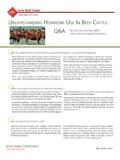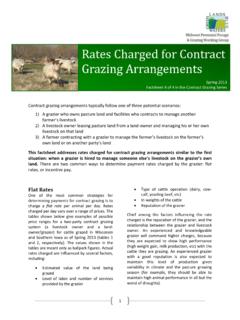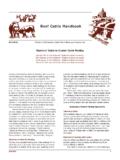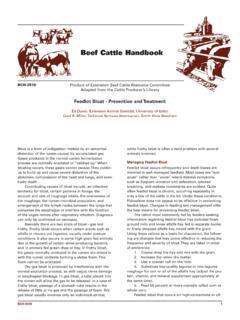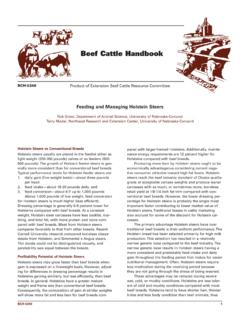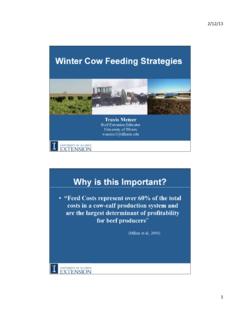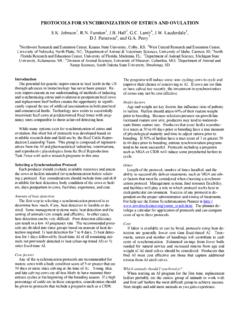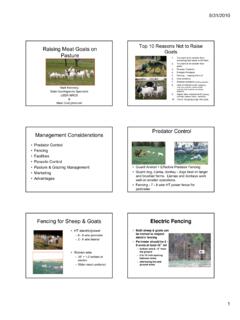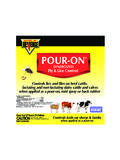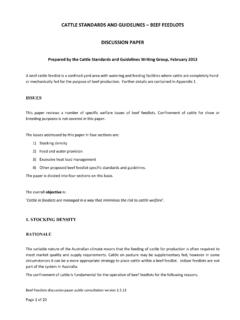Transcription of Pasture Rental and Lease Agreements - Iowa Beef …
1 1 Contract grazing arrangements typically follow one of three potential scenarios: 1) A grazier who owns Pasture land and facilities who contracts to manage another farmer s livestock 2) A livestock owner leasing Pasture land from a land-owner and managing his or her own livestock on that land 3) A farmer contracting with a grazier to manage the farmer s livestock on the farmer s own land or on another party s land This factsheet addresses Pasture and Lease Agreements pertaining to the second situation: when a livestock owner plans on managing their own cattle on land leased or rented from another person. Raising cattle on rented or leased land offers livestock producers the opportunity to affordably start or expand their operations and limit financial risk. With the high price of grains and the growing interest in grass-fed beef and dairy, managed productive pastures offer an alternate and affordable way to feed cattle.
2 Sheep and goats have traditionally been fed a mostly forage diet but managing their Pasture can lead to greater profitability. Additionally, land owners without livestock can consider leasing out their land to realize some income while giving a beginning farmer the chance to get established. What is the difference between a Rental agreement and a Lease for a Pasture Rental ? When you rent out a property, you will need to decide if you wish to offer your tenants a Lease or a Rental agreement . Although these terms are often used interchangeably, they are not the same. Rental Agreements are month to month, with no set period of residence. At the end of each 30-day period, both you and your tenant are free to change the Rental agreement (subject to any rent control laws).
3 These changes may include raising the rent, changing the terms of the initial agreement , or asking the tenant to vacate the property. However, in most states, both landlord and tenant are required to give 30 days notice before any changes can be made. If your state doesn't require notice, you can change any part of the Rental agreement at your discretion. A Rental agreement typically renews automatically after each 30-day period has elapsed. There's no need to give notice about this automatic renewal, as long as neither you nor your tenant has stated that the tenant will vacate the premises. Pasture Rental and Lease Agreements Spring 2013 Factsheet 3 of 4 in the Contract Grazing Series 2 A Lease has a set term, such as six months or a year, during which the tenant agrees to rent the property.
4 During that time (also known as the duration of the Lease ), the tenant and the landlord must adhere to the agreement . For example, tenants agree to make monthly rent payments and follow any code of conduct or other stipulations in the Lease . Neither party can change any terms of the agreement until the Lease expires, unless both parties agree to the change. A tenant can't vacate the property without breaking their Lease , in which case they can be held liable for the rest of the rent due under the Lease , or can be required to find someone else to take over the Lease . Amount to pay or charge: Both land owners (lessors) and graziers (lessees or renters) need to determine a fair Rental or Lease rate. What is a fair amount to charge for rent?
5 The answer is always: It depends . The devil is in the details and there can be many details to work out. You as a renter need to determine what kind of gain you can expect on livestock or how many animal units an acre can support. How you manage the Pasture can make a big difference on the stocking rate and rate of gain on the livestock. If you manage the Pasture as a continuously grazed system, the stocking rate and rate of gain could be different than if you rotationally graze in smaller paddocks or mob graze in a high density grazing system. The more gain you can achieve, the more you may be willing to pay or the less your risk might be. Typically, most pastures are rented by the month on a per-acre or per-head basis.
6 An alternative is to consider Rental rates based on an amount of gain in a season. Two very important items that must be clear and agreed upon are the maximum number of animals allowed on a unit of land and the weight of the animals. These will greatly affect the impact on the Pasture stand life and soil health. If you rent on an acre basis, you may overstock to reduce cost per head. If you rent on a per head basis, you may want to lower your stocking rate to improve rate of gain. These decisions might be in conflict with the landowner s expectations of how they want their land managed, so it s important to deal with these questions upfront in a written agreement . Consider some different scenarios A few potential scenarios illustrate the different ways of determining a whether a Rental or Lease rate is fair.
7 Scenario 1: You have a 75-cow beef herd and expect you will have 75 cow/calf pairs to put on Pasture May 1. You hear of a Pasture available to Lease for the year for $15,000 for 100 acres. Is this a fair price? In the past you have paid $1/cow/calf unit per day for Pasture Rental . If we can expect 180 days of Pasture growth adequate to support the 75 cow/calf units; our math would tell us that would equal $75/day in Pasture costs for 180 days which would equal $13,500. If you pay the $15,000, the cost comes out to $ or $ cow/calf unit per day. Scenario 2: As a second example, say you are looking at the same Pasture as in Scenario 1, but you have 75 bred Holstein heifers that you want to gain at least by calving time in the fall.
8 In order to achieve this rate of gain, it will be necessary to divide the Pasture into 30 paddocks with movable electric fencing which you will have to provide. It will also require you to move fences and animals daily. In this scenario, the fencing costs, and time and labor costs will be significant. 3 Someone who doesn t have the available time, or doesn t have the necessary fencing supplies on-hand, may decide that it makes more sense to pay someone else to raise the heifers for them. As an alternative to raising them yourself, the landowner offers to raise the heifers for a fee of $ (without offering a guaranteed rate of gain). This cost includes the land Rental and the grazing management the land Rental fee equals $ per day (from scenario 1) so the grazing management would be $ As the owner of the heifers, you d need to consider whether this is a grazing management cost you can beat by supplying your own subdividing fence materials and labor for daily moves.
9 These scenarios serve to illustrate things that need to be considered in negotiating a Pasture Lease , including: What is the forage production potential of the Pasture ; is it composed of diverse and productive grasses and forbs or weedy Kentucky Blue grass? What is the fertility status of the ground and who will be responsible for the additional fertilizer needed? What is the soil type? Is it good loam, or sandy and rocky with little water holding capacity? Who will pay for supplemental feed if required in time of drought? What is the water supply and quality in the Pasture and the location of the water source? Will different fencing plans work with the water available? What happens if the water supply dries up in late summer?
10 Who is responsible to provide water? The landowner is usually responsible for providing effective perimeter fences. The fencing for subdividing the Pasture into multiple paddocks in a more intensive system is usually the renter s option and responsibility. Whether it is a Rental agreement or a true Lease , the agreement should be put in writing with the guidance of legal counsel. The agreement should include the names of the parties involved, legal description of the land involved, length of the agreement , pay provisions and all of the other the items agreed upon. It should then be signed and dated before livestock take occupancy. For more information contact: Jim Paulson, University of Minnesota Dick Cates, University of Wisconsin Madison Phone: (320) 235-0726 x2001 Phone: (608) 588-2836 Email: Email: Other fact-sheets in this series include: The Basics of Contract Grazing Evaluating Land Suitability for Grazing Cattle Rates Charged for Contract Grazing Arrangements
